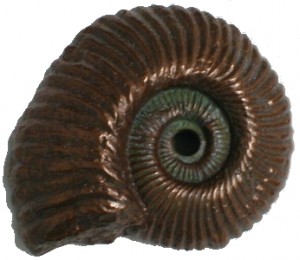No matter how well adapted an animal may be, it can spell evolutionary doom to have feathers or even shells that become coveted by human beings. Take the nautilus, a creature that pulled easily through the asteroid impact that wiped out the dinosaurs. It now hangs on the brink of extinction thanks to the misfortune of having a pretty spiraling shell.
These animals come from an ancient family, the nautiloids, that go back almost all the way to the birth of complex life 600 million years ago. Nautiloid fossils have been dated as early as 500 million years ago, soon after animals started leaving fossils.
British paleontologist Richard Fortey described their supreme reign in his new book “Survivors,” which describes so-called living fossils. For most of the last 500 million years, the nautiloid family was dominated by once sub-group – creatures called ammonoids, whose fossils reveal shells with intricate, lacy, fractal-shaped crinkles and folds. Different species of ammonoids swam together in schools, occupying different depths where they hunted and scavenged through the world’s ancient oceans.
They survived the worst of the major mass extinctions in the planet’s history – the end Permian event, which killed more than 90 percent of the world’s species 252 million years ago.
The story of the nautiloids helps illustrate the role of chance in evolution. Extinction doesn’t reflect some kind of flaw or weakness or inability to adapt. The term “fitness” as scientists use it depends on the environment – don’t think of workout-hardened athletes but of individuals that fit well into their surroundings. And on this planet, the surroundings are always subject to change.
The dinosaur-killing mass extinction 65 million years ago was bad luck for the ammoinoids but not the plainer, more humble nautilus, said Peter Ward, a professor of biology, earth and space sciences at the University of Washington. The difference was that ammonoids reproduced by making huge numbers of larvae that floated with the plankton near the water’s surface, while the nautilus lays a few large eggs several hundred feet beneath the surface. The deep waters were like a bomb shelter, said Ward, where generations of nautilus could live and reproduce in an environment that was relatively unaffected by the mass extinction. As cold-blooded creatures, they don’t need much food and can slow their metabolism down to a crawl in tough times. “They slept through the mass extinction, like nautilus van Winkle,” he said.
The nautilus may not seem as charismatic as tigers or elephants, but it holds a certain fascination. The spiral shells are divided into chambers, the biggest outermost one providing a home for the creatures and the empty ones providing an adjustable buoyancy system that allows the nautilus to move up and down after food. Not only is the nautilus a member of an ancient lineage, but individual creatures are long-lived. They may live upwards of 100 years, said Ward. He’s planning to analyze nautilus shells for traces of isotopes from the atom bomb blasts of the 1940s.
The nautilus is a scavenger, feasting on the molted skins of lobsters and hermit crabs. When it comes to smell, “they are like wolves, picking up an unbelievably small number of molecules,” Ward said. That makes them easy to trap, but it also means if a trap only gets a few animals in an evening, they may be the only residents for miles around.
Fortey’s book describes the nautilus along with other so-called living fossils – animals and plants that appear to have changed very little over tens of millions or even hundreds of millions of years. But Ward sees signs that the mass extinction 65 million years ago left them some room to evolve. Some started to become more complex in their shell designs, filling the niche vacated by their extinct cousins the ammonoids. DNA testing has shown that they’ve branched into a number of different species as populations spread out and separated. In recent years, the last members of the ancient nautiloid family have acquired a new, formidable enemy – fishermen. People don’t want the chipped, damaged shells that wash up on beaches, said Ward. There’s more money to be made from the unblemished specimens obtained by killing the animals. About half a million nautilus shells have been imported into the United States, where they’re sold in gift stores, Ward said.
Ward has led a series of ongoing expeditions to count the creatures, setting underwater traps set in their usual habitats in the Philippines, Australia’s Great Barrier Reef, Fiji and Samoa. The decline is precipitous. In areas where they once caught hundreds in a day, they now catch one or two.
In the Philippines, a rumor is fueling even more killing, Ward said. People are claiming that the nautilus makes pearls – even selling fake “nautilus pearls” made from polished pieces of snail shells.
They suffer the same problem seen in some long-lived, slow-reproducing fish: People spare the young and catch the bigger adults, which is exactly the opposite of what they should do. Most young won’t survive anyway, and a healthy population depends on a few lucky individuals who get to adulthood and from there continue to reproduce for decades.
So as hardy as these creatures have proven over hundreds of millions of years, a new fitness factor is becoming increasingly important – the ability to coexist with 7 billion human beings. There’s nothing the nautilus can do to adapt to the threat from humans – it came on too suddenly. The future of these animals depends not on what they do, but on what we do.
Courtesy: The Philadelphia Inquirer



 August 6th, 2012
August 6th, 2012  riffin
riffin 
 Posted in
Posted in  Tags:
Tags: 